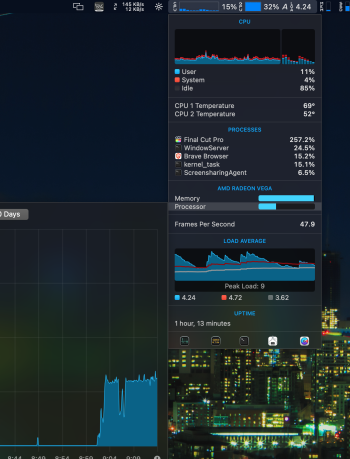So, as I mentioned my 5700XT has no problems for the last 6 months, other than not really performing as well as I’d hoped.
I did have some troubles connecting my TV (super old LG 1080p) via HDMI, and solved with DP-HDMI cabling.
UPDATE: Cable arrived, and it’s working fine. Even the TV is now plugged in via MiniDP>HDMI and picture quality seems better (maybe my imagination).
Of course the geekbench score is lower, but I get the PCIE back, and the 16gb HBM2 VRAM. Not sure how that might translate to video rendering, vs geekbench. My VRAM is always maxed when exporting projects but GPU processor maybe 36% on the 5700 XT. Same project on 2017 iMac with RX 580, is much faster using 100% of the GPU processor.
If you (or anyone) knows why that might be, I’d appreciate the input.
I get the 5,1 has super old processors, but Xeon 12c 3.46 vs i5 4c 3.8ghz can’t be that much of a difference?
UPDATE: Just ran some exports with final cut and still the GPU processor is using only 25-35%, Davinci no more than 20%. That said some other things seems smoother, like there's no lag when using screen remote, so that's a bonus.
It's hard to tell what's wrong.
1) Xeon 12C
3.46 vs i5 4C
3.8 isn't a good comparason. It looks like "just" 0.34GHz, which is just 10% clock speed difference. However, the 7600K is a much newer CPU, which has a much more efficient architecture. Therefore, the 7600K actually can do ~35% better than X5690 in single thread performance.
So, even though the software can use multi thread. But there is always one main thread. If that main thread is the bottleneck, then the 7600K will able to do ~35% faster.
2) Hardware encoding vs software encoding. I am not sure if you are using GPU's hardware encoding on the cMP. If not, and you are exporting H264 / HEVC. Then you may comparing hardware (iMac) to software encoding (cMP). This can also make a big difference.
e.g. On the iMac, the hardware encoding is fast. Therefore, the bottleneck is on the GPU rendering. That's why you can see the GPU is 100% utilised. It's because the GPU itself is the bottleneck.
But on cMP, if you are using software encoding, then the CPU encoding speed may be the actual bottleneck. Therefore, the GPU no need to work to 100%, because it is waiting for the CPU to free up to accept more frames. Therefore, you may only see ~36% utilisation.
If you have very fast storage, you may try to export ProRes in FCP, and see if that give you higher GPU utilisation rate. If yes, then "encoding speed" most likely is the bottleneck on your cMP.
N.B. All the above assume background rendering is disabled. Otherwise, if the timeline is pre-rendered, then of course the GPU doesn't need to work that hard during export (encoding).



